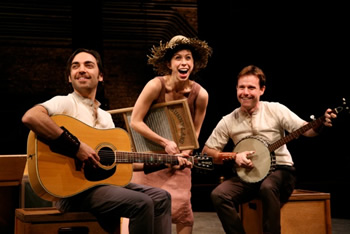The Queen City’s amazing dance company presented another thrilling set of dances in the Belk Theater in a three-day run that opened March 8. The program opened with Balanchine’s show-stopping Rubies, and from that high platform soared toward the cosmic.
The NCDT‘s associate artistic director, Patricia McBride, danced the premiere of Rubies nearly 40 years ago, and her restaging of this centerpiece of Balanchine’s three-part Jewels was clean and elegant. Set to Stravinsky’s Capriccio for piano and orchestra, the work has a bold brashness that makes it the most American of the three dances. Along with more classical turns and jumps, Rubies is built from an array of popular dance steps, from Cakewalk to Rumba, cut and faceted to dazzle the eye. If it glittered any more, it would be gaudy. But Balanchine knew just where to stop. Rubies is all flash and no trash.
From the moment the curtain went up on the gorgeous red and white arc of angled arms and legs, poised on pointe, through all the sassy motions to the final sparkling scene, the NCDT dancers, led by Rebecca Carmazzi, Addul Manzano and Traci Gilchrest, were just fabulous. Manzano moved like light bouncing off a shining stone, but all the dancers were beautiful. Pert, prancing and playful, they gave a full-spirited, but not sultry, interpretation. Their extremely precise timing and the ultra-crisp motions made this dance a very valuable jewel.
The only weakness was the sound. I am trying not to whine about the absence of live music at the ballet—I understand the money issue. But somebody needs to do something about the speakers or the amplifier or whatever is the problem in the Belk Theater (which is not alone in having inadequate equipment). The Stravinsky sounded horrible and the Villa-Lobos that came next was no better. Poor sound quality is not only insulting to the music, but diminishes the experience of the dance.
Where Rubies was bright and hard in its minerality, the work by Spanish choreographer Nacho Duato that followed was glowing and fecund in its evocation of the Amazonian rain forest. Na Floresta was danced, appropriately, barefoot, in rich dim light. As the dancers rolled, twined, soared, fluttered, wiggled and darted, they evanesced into branches, roots, fronds, and binding lianas. They grew, flowered and decayed, in the ceaseless organic cycle. When one rested, another was in motion. There were no pauses. Brazilian-born Andre Teixeira was perhaps a shade more attuned to the music and the subject than the other dancers, but really, they were all so wonderful in this very beautiful choreography that they can’t be ranked. That is one of the most exciting things about this company. They are a powerful ensemble, the tremendous skills of each supporting those of all the others. Yet each dancer has a huge and distinctive stage personality. All are stars.
So too is NCDT’s resident choreographer Dwight Rhoden. His Set Rise Fall, which closed the program, is another wide-open, all-out, full-tilt extravaganza. The work was commissioned by Hugh McColl (who sponsored the whole show) in honor of his wife, Jane Spratt McColl — the latest of many gifts in the arts that the McColls have made. If this dance is at all like her, she must be one amazing woman.
Rhoden likes to mix it up—the music, the dance styles, the gender roles, you name it. He is one of the rare artists who really knows how to use the post-modern penchant for mix and match, and this is because he doesn’t throw the unity out with the bathwater. His work is madly varied, but it is whole. Set Rise Fall begins with music from the Fifth Dimension (“Let the Sun Shine In”) and continues with the Bang on a Can All-stars, Steve Reich, Chopin, Sweet Honey in the Rock, etc. etc. Reading the list, you think — this cannot possibly work. But it is brilliant.
At one level the piece is a paean to the light, with ecstatic dancing from the priests and priestesses of the sun (Nicholle Rochelle is the high priestess, maybe even a goddess herself, and Sasha Janes is right there with her). At another level, it seems like a glory song to the human animal. It’s all sizzling energy–the sexual energy that’s the equivalent on earth to the sun’s energy in the heavens. Both are requisites of life. Whichever way you want to look at it, it is some awesome natural beauty, and when Sweet Honey sings the closing anthem, “Amen, Amen,” all you can say is, so be it.











